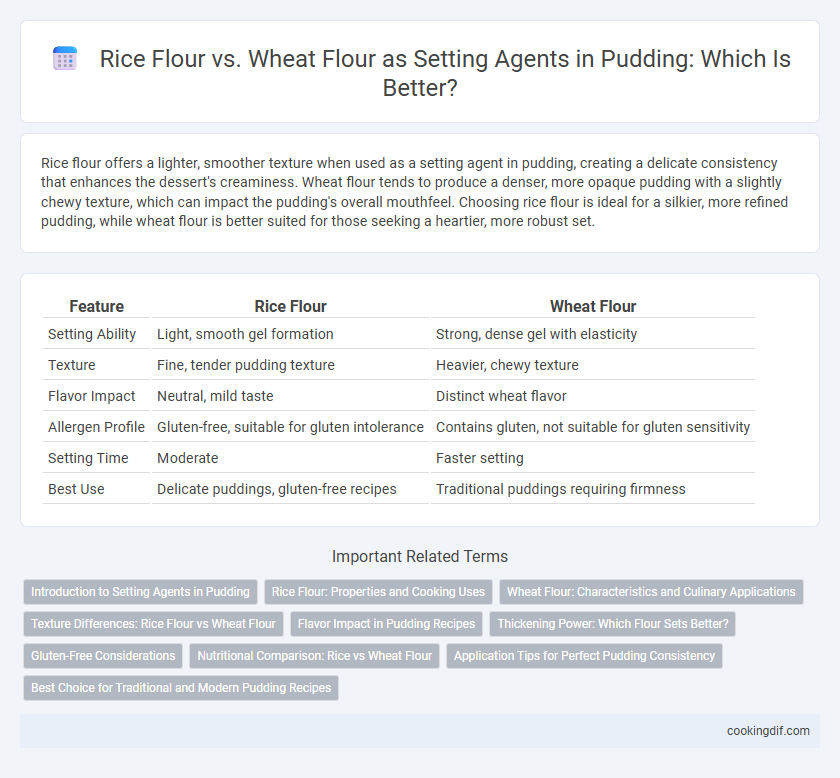Rice flour offers a lighter, smoother texture when used as a setting agent in pudding, creating a delicate consistency that enhances the dessert's creaminess. Wheat flour tends to produce a denser, more opaque pudding with a slightly chewy texture, which can impact the pudding's overall mouthfeel. Choosing rice flour is ideal for a silkier, more refined pudding, while wheat flour is better suited for those seeking a heartier, more robust set.
Table of Comparison
| Feature | Rice Flour | Wheat Flour |
|---|---|---|
| Setting Ability | Light, smooth gel formation | Strong, dense gel with elasticity |
| Texture | Fine, tender pudding texture | Heavier, chewy texture |
| Flavor Impact | Neutral, mild taste | Distinct wheat flavor |
| Allergen Profile | Gluten-free, suitable for gluten intolerance | Contains gluten, not suitable for gluten sensitivity |
| Setting Time | Moderate | Faster setting |
| Best Use | Delicate puddings, gluten-free recipes | Traditional puddings requiring firmness |
Introduction to Setting Agents in Pudding
Rice flour offers a smooth texture and neutral flavor, making it an effective setting agent in pudding for creating a delicate and creamy consistency. Wheat flour contains gluten, which provides a firmer structure but may yield a denser texture in pudding compared to the lighter set achieved with rice flour. Selecting the appropriate flour impacts the pudding's firmness, mouthfeel, and overall sensory experience.
Rice Flour: Properties and Cooking Uses
Rice flour, prized for its fine texture and neutral flavor, serves as an excellent setting agent in pudding, creating a smooth, cohesive consistency without altering taste. Its gluten-free nature makes it ideal for sensitive diets and produces a tender, delicate pudding compared to the denser result from wheat flour. Rice flour's high starch content gelatinizes effectively during cooking, enhancing the pudding's firmness while maintaining a light mouthfeel.
Wheat Flour: Characteristics and Culinary Applications
Wheat flour, rich in gluten proteins, provides excellent binding and thickening properties, making it an effective setting agent in pudding preparation. Its capacity to form a smooth, elastic texture enhances the structural integrity of puddings, resulting in a creamier and more cohesive consistency. Commonly used in recipes like bread puddings and custards, wheat flour contributes both flavor and body, distinguishing it from rice flour's lighter, grainier texture.
Texture Differences: Rice Flour vs Wheat Flour
Rice flour creates a smoother and silkier pudding texture due to its fine granules, which absorb liquids evenly and result in a creamier consistency. Wheat flour, containing gluten, tends to produce a denser pudding with a slightly chewy texture, offering more structure but less smoothness. The choice between rice flour and wheat flour significantly impacts the mouthfeel and firmness, with rice flour favoring delicate softness and wheat flour providing a more robust body.
Flavor Impact in Pudding Recipes
Rice flour imparts a subtle, neutral flavor to pudding, enhancing its creamy texture without overpowering the delicate taste of vanilla or fruit additives. Wheat flour contributes a mild, slightly nutty flavor that can enrich the overall profile, but it may mask more delicate ingredients due to its stronger presence. Choosing rice flour over wheat flour results in a pudding with a cleaner, more pronounced sweetness, ideal for recipes emphasizing pure flavor clarity.
Thickening Power: Which Flour Sets Better?
Rice flour provides a smoother, lighter texture in puddings due to its fine granules and moderate thickening power, making it ideal for delicate desserts. Wheat flour has stronger thickening properties because of its higher gluten content, resulting in a denser and firmer pudding consistency. For a perfectly set pudding with a creamy yet stable structure, rice flour is preferable, while wheat flour suits recipes requiring a more robust, chewy texture.
Gluten-Free Considerations
Rice flour serves as an excellent gluten-free setting agent in pudding recipes, providing a smooth texture without triggering gluten-related sensitivities. In contrast, wheat flour contains gluten, which can compromise the pudding's consistency for those with celiac disease or gluten intolerance. Selecting rice flour ensures both a safe and creamy pudding, meeting dietary needs without sacrificing quality.
Nutritional Comparison: Rice vs Wheat Flour
Rice flour offers a gluten-free alternative with a higher carbohydrate content and lower protein levels compared to wheat flour, making it ideal for lighter, less dense puddings. Wheat flour contains more fiber, vitamins B and E, and essential minerals like iron and magnesium, contributing to better nutritional value and firmer pudding texture. Choosing between rice and wheat flour affects not only the pudding's consistency but also its nutritional profile, important for dietary preferences and health considerations.
Application Tips for Perfect Pudding Consistency
Rice flour offers a smoother, silkier texture in puddings due to its fine granules and neutral taste, making it ideal for delicate desserts. Wheat flour, with its higher gluten content, can result in a denser pudding and requires careful cooking to avoid a gummy consistency. For perfect pudding results, gradually whisk rice flour into cold milk before heating, while wheat flour mixtures benefit from slow simmering and constant stirring to ensure even thickening.
Best Choice for Traditional and Modern Pudding Recipes
Rice flour provides a smooth, translucent texture ideal for traditional puddings, while wheat flour offers a denser, creamier consistency preferred in modern recipes. As a setting agent, rice flour is gluten-free and delivers a lighter mouthfeel, making it suitable for delicate, custard-like puddings. Wheat flour's gluten content contributes to a firmer set and richer flavor, enhancing the texture in hearty, contemporary pudding variations.
Rice flour vs Wheat flour for setting agent Infographic

 cookingdif.com
cookingdif.com